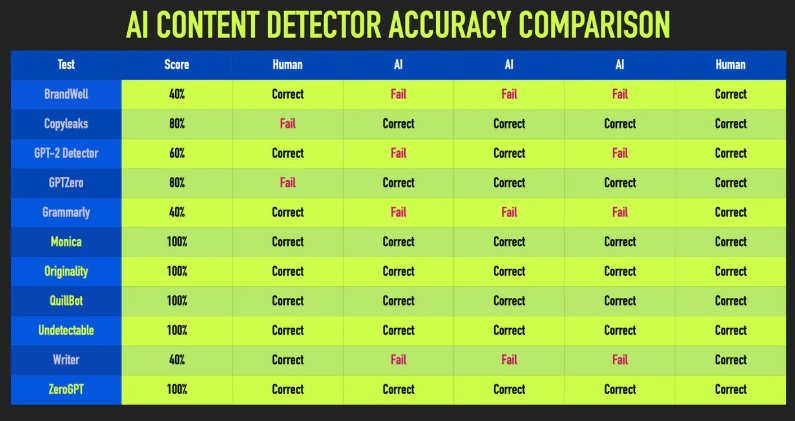
Are you struggling to discern human-written content from AI-generated text? The increasing sophistication of AI writing tools demands robust detection methods. This article dives into the critical landscape of AI detector accuracy, highlighting the top contenders for 2025.
What You'll Learn:
- The crucial importance of AI detector accuracy in various sectors for 2025.
- A curated list of leading premium and budget-friendly AI detection tools.
- Key criteria and a framework for selecting the most suitable AI detector for your needs.
- Insights into the evolving market trends and future outlook of AI content detection.
Why AI Detector Accuracy Matters in 2025
In 2025, the stakes for accurately identifying AI-generated content are higher than ever. As artificial intelligence continues its rapid advancement, distinguishing between human and machine authorship is becoming increasingly complex, yet incredibly vital.
Current Market Trends
The proliferation of AI content generation tools has created a significant demand for reliable detection methods. Educational institutions are grappling with plagiarism concerns, businesses are wary of misinformation and brand reputation damage, and content creators are seeking to maintain the authenticity of their work. This has led to a surge in the development and adoption of AI detection software. According to Statista, the AI market is experiencing exponential growth, directly fueling the need for tools that can navigate its outputs. We're seeing a shift from basic keyword analysis to more sophisticated pattern recognition and stylistic analysis.
Future Outlook
The future of AI detector accuracy is a dynamic race. As AI models become more advanced, they will inevitably learn to circumvent current detection methods. This means that AI detectors must continuously evolve, incorporating machine learning and natural language processing techniques to stay ahead. Experts predict a greater emphasis on contextual understanding and behavioral analysis rather than just linguistic patterns. The ethical implications of AI content are also a growing concern, making accurate detection a cornerstone of responsible AI deployment. Organizations like the World Wide Web Consortium (W3C) are actively working on standards that could influence how AI-generated content is identified and managed.
Top AI Detector Accuracy Options
Choosing the right AI detection tool can be challenging given the expanding market. Here's a breakdown of some of the top-tier solutions and more accessible alternatives for 2025.
Premium Solutions
These tools often offer advanced features, higher accuracy rates, and dedicated support, making them ideal for professional use cases.
- GPTZero: Widely recognized for its robust detection capabilities, GPTZero uses a combination of perplexity and burstiness analysis to identify AI-generated text. It's a popular choice among educators and researchers. You can find more about its underlying principles on developer.mozilla.org.
- Copyleaks AI Content Detector: Copyleaks offers a comprehensive suite of tools, including a highly accurate AI content detector. It boasts a high detection rate and provides detailed reports.
- Writer AI Content Detector: Focused on enterprise solutions, Writer's detector is integrated into its broader AI writing platform, ensuring consistency and brand voice compliance.
Budget-Friendly Alternatives
For individuals or smaller organizations, these options provide effective AI detection without a significant financial commitment.
- Crossplag: This tool offers a free AI content detector that can be surprisingly effective for basic detection needs.
- Sapling AI Detector: Sapling provides a free tool that's easy to use and can give a good indication of AI authorship.
- Writer.com's Free AI Content Detector: Similar to its premium offering, Writer also provides a free version that's accessible for quick checks.
To help illustrate the differences, here's a comparison of some key features:
| Feature | GPTZero | Copyleaks AI Detector | Sapling AI Detector |
|---|---|---|---|
| Accuracy | High | Very High | Moderate |
| Pricing Model | Freemium | Subscription | Free |
| Use Cases | Education, Research | Enterprise, Publishers | Individuals, Students |
| Report Detail | Good | Excellent | Basic |
| Ease of Use | Very Good | Good | Excellent |
How to Choose the Right AI Detector Accuracy
Selecting an AI detector that aligns with your specific needs requires careful consideration of several factors.
Selection Criteria
When evaluating AI detection tools, keep these crucial criteria in mind:
1. Accuracy Rate: This is paramount. Look for tools that consistently demonstrate high accuracy in independent tests. Some tools may claim higher accuracy but struggle with nuanced content.
2. Type of AI Models Detected: Ensure the detector can identify content from a broad range of AI models, not just a select few.
3. False Positive/Negative Rate: A high false positive rate (flagging human content as AI) or a high false negative rate (missing AI content) can be detrimental.
4. Ease of Use: The interface should be intuitive, allowing for quick and efficient scanning of text.
5. Integration Capabilities: For businesses, integration with existing workflows or platforms can be a significant advantage.
6. Cost: Budget constraints will naturally influence your choice.
7. Privacy and Data Security: Understand how the tool handles your data, especially if you're scanning sensitive content. You can find information on data handling practices from organizations like the Internet Watch Foundation (IWF).
Decision Framework
Here’s a simple framework to guide your decision-making process:
1. Define Your Primary Need: Are you an educator, a content marketer, a researcher, or a student? Your primary use case will dictate the required level of sophistication and accuracy.
2. Research and Test: Utilize free trials or free versions of tools to test them with content you know is either human-written or AI-generated. Compare their results. You can find resources on evaluating AI tools on Coursera.
3. Compare Features and Pricing: Create a comparison table (like the one above) for your shortlisted tools, focusing on features critical to your needs and their respective costs.
4. Read Reviews and Case Studies: Look for feedback from users in similar industries or with similar challenges. Websites like The Verge often feature reviews of emerging technologies.
5. Consider Future Scalability: If your needs are likely to grow, opt for a solution that can scale with you, rather than one you'll quickly outgrow.
“The accuracy of AI detection tools is not a static benchmark. It's a moving target that requires continuous innovation and adaptation to keep pace with AI advancements.”
FAQ (Frequently Asked Questions)
##
Q: How accurate are AI detectors in 2025?
A: AI detector accuracy in 2025 varies significantly between tools. Top-tier solutions are achieving accuracy rates upwards of 95% for well-known AI models. However, detecting highly sophisticated or fine-tuned AI content can still be challenging, and no detector is 100% foolproof. Factors like the specific AI model used, the complexity of the prompt, and post-editing can all influence detection results.
Q: Can AI detectors distinguish between human writing and AI writing that has been edited by a human?
A: This is one of the most challenging aspects for AI detectors. Human editing can introduce nuances, stylistic variations, and errors that make AI-generated text appear more human-like. While advanced detectors can sometimes flag heavily edited AI content, their effectiveness is reduced compared to detecting raw AI output.
Q: Are free AI detectors reliable?
A: Free AI detectors can be useful for basic checks and for identifying obvious AI-generated content. However, they typically lack the sophisticated algorithms and extensive training data of premium tools. Therefore, their accuracy may be lower, and they might be more prone to false positives or negatives. For critical applications, investing in a reputable paid tool is generally recommended. You can learn more about the principles of natural language processing on python.org.
Q: What are the ethical implications of using AI detectors?
A: Ethical considerations include potential bias in detection algorithms, the risk of unfairly penalizing students or creators whose work is misidentified, and the privacy concerns related to submitting text to third-party detectors. It's important to use AI detectors responsibly and as a tool to inform judgment, rather than as an absolute arbiter of authorship.
Q: How often should I use an AI detector?
A: The frequency of use depends on your specific needs. Educators might use them for assignments, content managers for blog posts, and researchers for academic integrity. For content creators focused on originality, regular checks can help ensure their work remains authentic. For specific guidelines on academic integrity, you might refer to resources from institutions like MIT.
Conclusion
Navigating the landscape of AI-generated content in 2025 requires vigilant and accurate detection tools. Understanding the evolving market, evaluating premium and budget-friendly options based on clear criteria, and employing a structured decision framework are essential steps. As AI technology continues its rapid ascent, so too must our methods for discerning its output.
Ready to ensure the authenticity of your content? Explore the top AI detectors and find the perfect fit for your needs today!






